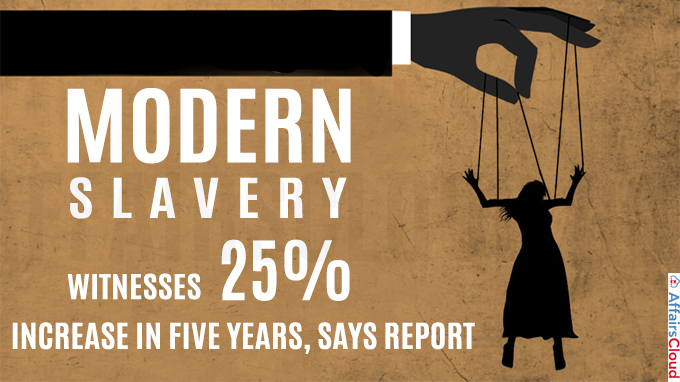 According to the “Global Estimates of Modern Slavery-Forced Labour and Forced Marriage,” released by the International Labour Organization (ILO), there were approximately 50 million (49.6 million) people living in modern slavery on any given day in 2021, up from 40 million in 2016 and a 25% increase over the last 5 years.
According to the “Global Estimates of Modern Slavery-Forced Labour and Forced Marriage,” released by the International Labour Organization (ILO), there were approximately 50 million (49.6 million) people living in modern slavery on any given day in 2021, up from 40 million in 2016 and a 25% increase over the last 5 years.
- Of these people, 22 million were trapped in forced marriages and nearly 28 million (27.6 million) were subjected to forced labour. The most vulnerable members of society continue to be women and children.
The ILO, Walk Free, and the International Organization for Migration (IOM) developed the global and regional estimates stated in this report.
Key Terminologies
- Modern Slavery refers to a set of specific legal concepts, such as forced labour, concepts related to forced labour (such as debt bondage, slavery, and slavery like practices and human trafficking), and forced marriage.
- Forced Marriage refers to instances in which a person is forced to marry without their consent.
Key Statistics: The Wake-up Call
Upper-Middle Income or High-Income countries account for more than half (52%) of all forced labour and a quarter of all forced marriages.
Forced Labour
i.The number of people who are forced to work has increased by 2.7 million between 2016 and 2021.
ii.Asia and the Pacific countries account for more than half of the global total i.e.,15.1 million labourers.
- This is followed by Europe and Central Asia (4.1 million), Africa (3.8 million), the Americas (3.6 million), and the Arab States (0.9 million).
iii.According to the report, the Arab States have the largest population proportion (5.3 per thousand people), followed by Europe and Central Asia (4.4 per thousand).
iv.The private sector accounts for 86 % of all instances of forced labour.
Forced Marriage
i.In 2021, there were an estimated 22 million people living in forced marriages on any given day. Between 2016 and 2021, the number of people in forced marriages climbed by 6.6 million.
- Asia and the Pacific account for nearly two-thirds (65%) of all forced marriages, which impact an estimated 14.2 million people.
- This is followed by 14.5% in Africa (3.2 million) and 10.4% in Europe and Central Asia (2.3 million).
ii.When the population of each region is taken into consideration, the Arab States have the highest rate of forced marriage (4.8 per thousand population), followed by Asia and the Pacific (3.3 per thousand population).
iii.According to the report, adult migrant workers have a more than threefold risk of being subjected to forced labour than non-migrant adult workers.
Note: By adopting the Sustainable Development Goals (SDGs), the international community pledged to put an end to modern slavery among children by 2025 and universally by 2030 (Target 8.7).
Recent Related News:
In July 2022, A Memorandum of Understanding (MoU) was signed between Department of Chemicals and Petrochemicals (DCPC) and ILO for adopting the International Chemical Safety Cards (ICSCs). Dr. Mansukh Mandaviya, Union Minister for Chemicals and Fertilisers and Health & Family Welfare chaired a seminar on ‘Safe Use of Chemicals at Workplace’.
About International Labour Organisation (ILO):
Director-General – Guy Ryder (Gilbert F. Houngbo will occupy the office in October 2022.)
Establishment – 1919
Member States – 187




